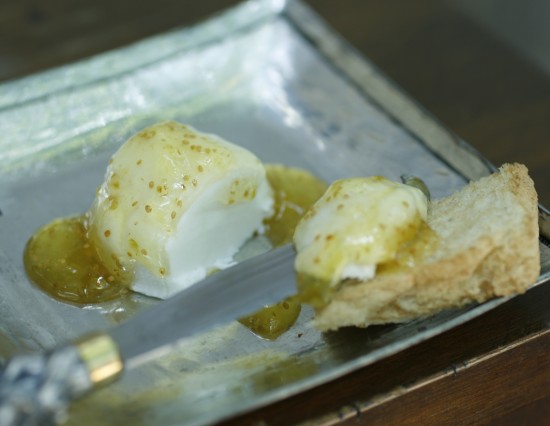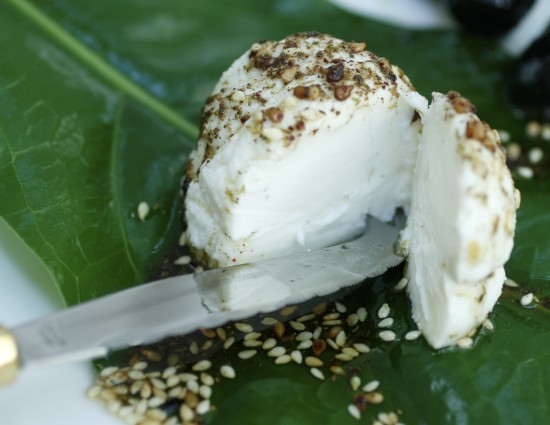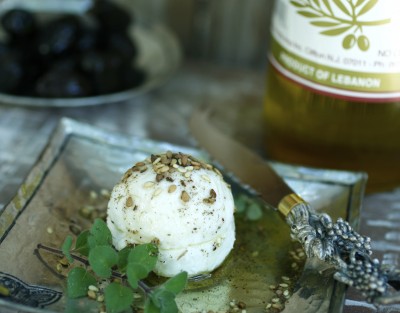Goat cheese balls
October 20, 2009 • Category: Eggs/Dairy/Cheese

Lebanese people, who count resourcefulness as one of their virtues, have always made homemade cheese. I remember my grandmother using a muslin bag to drain the yoghurt that she made on a weekly basis. She would hang the bag over the sink and the next day, we’d have fresh cheese or as we call it labneh. Labneh is a fresh cheese that is simply yoghurt that is drained of its whey. It is consumed every day in a traditional Lebanese home, with olive oil, scooped up with a small piece of pita bread and maybe some olives or zaatar or small pieces of tomatoes and cucumber.
I decided to take it one step further and make labneh balls, which is part of the provisions that traditional Lebanese people make. Labneh balls are simply made of labneh (yoghurt cheese or yoghurt minus the whey) that has been drained further until no moisture remains. Then, the cheese is hand-shaped into little tiny balls and preserved in a jar with some extra-virgin olive oil. The labneh balls will be safe in the sterilized jar for up to one year.
In Lebanon, there is a Jesuit monastery in a small village in the central Bekaa valley that is famous for its labneh production. I would buy their labneh in a heartbeat if it was available in the US. When visitors stop in that village of 800 inhabitants on their way to a festival at Baalbeck, you see hordes of people kicking and screaming ordering labneh sandwiches from the cafés, acting as if they haven’t had any food in their system for one week! It is pretty amazing to watch. But such is the importance of labneh for the Lebanese folks.
There are two main types of labneh. The fresh kind, that is extracted from yoghurt and the preserved labneh that is simply regular labneh drained a few days longer until very little moisture remains. The preserved labneh is soaked in extra-virgin olive oil. If you open a jar of the preserved cheese, it is a good idea to keep it in the fridge until it is all consumed.
This recipe represents the quintessential slow-food experience! It actually takes about 7 days to make this cheese! You might think, wait a minute, 7 days? Yeah, but each day, all you do is change from wet to dry paper towels under the cheese balls, which takes less than 5 seconds.
And one day, you look at the cheese balls and you know they are ready. Here comes the olive oil (your best) and a clean, sterilized mason jar. You have made some fine cheese that you can either gobble that week or keep for six months or up to a year somewhere, or give to a nice person who will appreciate the gesture.
To sterilize the jars:
- Wash jars and lids and screw bands in hot soapy water then rinse well.
- Dry screw bands.
- Put jars and lids in a 8 to 10 quart deep pot.
- Add enough water to cover by 2 inches.
- Heat water until an instant-read thermometer reads 180F. Do not let boil.
- Keep jars submerged in hot water, covered, until ready to use.
( Source: Gourmet magazine, online edition) and for the labneh balls my source was Slow-Food Lebanon.
INGREDIENTS: One jar of yoghurt will yield 12 balls of cheese, 1 1/2 inch in size or 24 1/2 inch balls.
Goat cheese yoghurt 32 ounces (900g)
2 teaspoons of sea salt
1 sieve, a bunch of paper towels and a muslin bag (optional
METHOD:
- Get the best quality yoghurt you can find, one with live and active cultures. Add some salt to it, mix and pour the content of the container into a sieve that has been lined with a few paper towels, or a large coffee filter or better yet, a muslin bag.
- Set the sieve over a bowl but try not to let the bottom of the bowl touch the sieve. If using a bag hang it somewhere and let it drip. Over the sink is a good place.
- Let the yoghurt drain for 2 or 3 days. You should get about 12 ounces of liquid (whey) under the sieve.
- Flip the mass of yoghurt onto a bowl. With a cookie scoop or your hands, form small even-sized balls and delicately set them on a large platter lined with 2 layers of paper towels.
- Cover the platter of small yoghurt balls with 2 layers of paper towels and press gently.
- Check every day. When the towels are moist, change them for dry ones. Do this about 4 or 5 days.
- Check your (now) yoghurt cheese. It should be firm and fairly dry.
- You can consume right away. Either sweet or savory.












OPTIONS:
- Cover with extra-virgin olive oil and place in a jar to save for later.
- Cover with some olive oil and zaatar and eat right away!
- Cover with fig jam
- Eat with toasted pine nuts and dried apricots plumped up in a light syrup.
- Ad infinitum….
Comments
22 Comments • Comments Feed



Alice Kezhaya says:
This was so delicious! Especially with the jam!
On October 20, 2009 at 10:16 pm
Joumana says:
So glad you liked it. First time I ever try it with fig jam and I love it too!
On October 22, 2009 at 9:54 am
HistoryOf GreekFood says:
From time to time, my Lebanese green grocer brings preserved labneh balls made by his father. I love them!!
On October 21, 2009 at 1:53 am
Joumana says:
What a great idea! Here we can only find them imported and the homemade ones taste a million times better!
On October 21, 2009 at 7:30 am
Rosa says:
A delightful speciality!
Cheers,
Rosa
On October 21, 2009 at 12:26 pm
Joumana says:
Thanks Rosa!
On October 21, 2009 at 2:04 pm
Lorraine @ Not Quite Nigella says:
That’s wonderful! Thankyou so much for sharing this recipe! 😀
On October 22, 2009 at 6:03 am
Joumana says:
I hope you try it Lorraine. It is so easy to make and the result will be as good as the best goat cheese you can buy. Guaranteed!
On October 22, 2009 at 9:47 am
Dana says:
Hi Joumana,
I am curious to know whether these labne balls have the sour bite that you typically get when made from Lebanese-style goat yoghurt. I have attempted before making Labne from greek style yoghurt and it oftern turned out like sour cream. I once even tried making yoghurt out of milk and it still turned out like sour cream.
btw, did you get a chance to visit the farm that sells fresh goat milk?
Cheers,
Dana
On October 24, 2009 at 11:53 am
Joumana says:
Hi Dana
I think these labneh balls taste faintly of fresh chevre. Not musky, not sour at all! Now I bought the yoghurt at Wholefoods, it is imported from California. Next time I will get the one from Latte Da Dairy. I visited them online and I am planning to go there soon! (Flower Mound is a little drive from my place)
So, bottom line, no they don’t taste sour at all.
On October 24, 2009 at 12:41 pm
I Sicilian says:
I so much enjoyed reading about the different cheeses on your blog. I have been thinking of posting a cheese spread on mine and this certainly motivates me. Love the goat cheese recipe
On June 12, 2010 at 6:54 pm
domi says:
C’ est beau et très appétissant mais difficile pour moi de me faire une idée du goût même si je ne doute pas de sa saveur….
On March 3, 2011 at 3:40 pm
kouky says:
merci Joumana pour cette délicieuse recette! je prépare la labné pour la consommer comme une sauce, mais je ne l’ai jamais égouttée aussi longtemps.
dois je conserver au frais durant la période de séchage? merci!
On March 10, 2011 at 3:54 am
Joumana says:
@Kouky: ouil il est préférable de conserver au frais durant la période de séchage.
On March 10, 2011 at 9:42 am
recette tiramisu says:
merci admin pour cette article
On April 1, 2011 at 8:09 am
Isabelle says:
Encore une bonne recette ! Aujourd´hui j´essaie de fromage de chèvre frais et je lis “Origines” d´un de mes auteurs préférés Amin Maalouf. Lebanese mood. Happy weekend ! Et merci.
On June 4, 2011 at 2:29 am
A Canadian Foodie says:
What a fantastic tutorial. I make yogurt cheese and yogurt cheese balls all of the time – but have never dried the balls. I must try this. Are you a Slow Food member, Joumana? I am on the Canadian Slow Food executive and this is a passion of mine.
🙂
V
On December 2, 2012 at 10:26 am
Audrey says:
Can I just clarify, do I leave the rolled balls on the paper towel out of the fridge for the 4-5 days? Thanks
On December 9, 2012 at 4:46 am
Joumana says:
@Audrey: Thanks for your question, I need to clarify this point; no the rolled balls are sitting on a cookie sheet and are on paper towels in the fridge.
On December 9, 2012 at 6:55 am
Audrey says:
Thanks Joumana, yummmm…. the first batch turned out beautifully. I am making some now for the Christmas table. Audrey
On December 15, 2012 at 8:34 pm